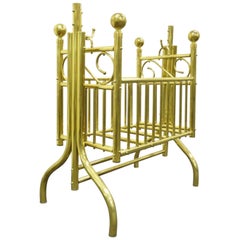Used Corsican Crib
Mid-20th Century Hollywood Regency Used Corsican Crib
Brass
People Also Browsed
1890s French Art Nouveau Used Corsican Crib
Bentwood
19th Century Used Corsican Crib
Iron
1890s French Art Nouveau Used Corsican Crib
Bentwood
Late 19th Century French Art Nouveau Used Corsican Crib
Fruitwood
19th Century English Victorian Used Corsican Crib
Textile, Silk
1890s Regency Used Corsican Crib
Fabric, Wood
Late 19th Century French Used Corsican Crib
Metal
21st Century and Contemporary American Modern Used Corsican Crib
Brass
19th Century Italian Rococo Used Corsican Crib
Fruitwood
Early 20th Century French Victorian Used Corsican Crib
Brass, Bronze
A Close Look at Hollywood-regency Furniture
The California-born style of Hollywood Regency, also known as Regency Moderne, emerged during the Golden Era of cinema from the 1920s to the ’50s. Decadent and bold, vintage Hollywood Regency furniture and interiors playfully mix colors like jewel tones and hot pinks with lacquered walls, gilded accents, mirrored surfaces and metallic finishes for maximalist spaces.
Although it involved elements of the coinciding Art Deco movement, such as a preference for clean lines, Hollywood Regency was much more opulent, inspired by glamorous movie stars and the lavish set designs for films being made in Tinseltown. Furniture designers associated with the style embraced an eclectic range of influences, including throwbacks to previous styles of grandeur, such as Rococo, neoclassical and chinoiserie, as well as materials, from bamboo dining chairs to lucite bar carts to sunburst mirrors made from gilded resin. Hollywood Regency end tables, floor lamps, chandeliers and other pieces tended to be small-scale, fitting into an overall design rather than serving as a focal point.
Interior decorator Dorothy Draper led the shaping of the Hollywood Regency style and also designed iconic pieces like the España chest, which was manufactured by Henredon. Virginia native William “Billy” Haines, a furniture designer who started as an actor, contrasted hand-painted wallpaper with Chinese ceramics and Chippendale chairs, while architect John Elgin Woolf imbued his Beverly Hills designs with theatrical details. Paul Revere Williams, a trailblazing African-American architect, was pivotal in defining the look through his commercial projects, such as the 1940s Beverly Hills Hotel and bespoke homes that mixed everything from Louis XV paneling to Georgian architecture.
Find a collection of vintage Hollywood Regency bedroom furniture, tables, seating and other pieces on 1stDibs.
Finding the Right Childrens-furniture for You
When you’re shopping for antique, new and vintage children’s furniture, you’ll want your choices to fit nicely within the decor scheme of the rest of your home. But you’ll also want to create an alluring and inspirational space for your children to feel relaxed and encouraged creatively. Indeed, a child’s room can be simultaneously stylish and playful — the ideal environment for children.
Understandably, beds were the first piece of furniture designed for young children. In Ancient Egypt, children’s beds were scaled-down versions of adult beds. They were intended to be a logical size for a child and low enough to the ground so that they could climb in by themselves.
Historians discovered early high chairs in Ancient Greece. In the 6th century B.C., a child’s training potty might have also been used as a high chair, while archaeologists on a dig discovered a terracotta high chair in a marketplace in Athens. By the Renaissance period, children’s bookshelves were popular with upper-class families who had disposable income and the desire to beautify all areas of the home. The original purpose was to organize school books, but shelves eventually became integral to children’s rooms of the era.
In the early 20th century, Italian physician Maria Montessori changed the way designers thought about children’s furniture. She wrote that it was important for children to have a safe environment of their own that they could easily navigate. Montessori believed that children’s furniture should be sized for them but that it should also be made of light, durable materials so that it’s easy for them to carry if needed.
Today’s widely known mid-century modern furniture designers took interest in the idea that young children should have well-crafted furniture of their own. You can find vintage mid-century modern children’s furniture created by the likes of Harry Bertoia, Charles and Ray Eames and Alvar Aalto. Contemporary industrial designer and architect Philippe Starck is also known for having introduced versions of his furniture that were geared toward children, especially his seating and storage solutions.
It’s never too early for good design. Decorating a child’s room offers the opportunity to combine elevated furnishings and a youthful spirit and can result in spaces that are at once elegant and whimsical. On 1stDibs, find design ideas for children’s rooms as well as a variety of new, antique and vintage children’s furniture today.
